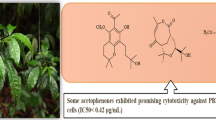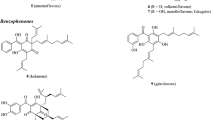Abstract
Dorema glabrum (Apiaceae) is a monocarpic plant distributed in southern Caucasus. The gum-resin of this species is traditionally used as diuretic and anti-diarrheal and for the treatment of bronchitis and catarrh. In the present study, free radical-scavenging activity and total phenolic content of the essential oil together with n-hexane, chloroform, ethyl acetate, and methanol extracts of D. glabrum roots were evaluated in DPPH and Folin-Ciocalteu assays, respectively. Methanol extract with the highest free radical-scavenging activity (IC50 = 74.2 ± 6.6 μg ml−1) and total phenolic content (186.7 ± 8.6 mg GAE/g) was subjected to phytochemical investigation using different chromatographic methods on the Si gel (normal and reversed-phase) and Sephadex LH-20 columns. Chemical constituents of the roots oil were also analyzed using GC and GC–MS. Two new phloroacetophenone glycosides, azerosides A (1) and azerosides B (7), along with nine known phenolic compounds, echisoside (2), pleoside (3), hyrcanoside (4), 7,8-dihydroferulic acid-4-O-β-d-glucopyranoside (5), Lavandoside (6), 6,7,8-trihydroxycoumarin (8), chlorogenic acid (9), 4,5-Di-O-caffeoylquinic acid (10), and cynarin (11), were isolated and identified from D. glabrum roots. Among the isolated compounds, 8–11 exhibited potent free radical-scavenging activity (IC50 values of 1.8–2.7 μg ml−1) in comparison with BHT (IC50 = 19.5 ± 0.8 μg ml−1). Twenty-six compounds were also identified in the roots oil, among them myristicin (14.1 %) and elemicin (11.7 %), two bioactive phenylpropanoid derivatives, were main compounds. This study introduces D. glabrum as a source of phloroacetophenone glycosides and caffeoylquinic acid derivatives and suggests it as an appropriate candidate for further pharmacological and toxicological studies.


Similar content being viewed by others
References
Adams RP (2007) Identification of essential oil components by gas chromatography/mass spectrometry. Allured Publishing Corporation, Carol Stream
Amanzadeh Y (2002) Ammoniacum gum. In: Committee Editorial (ed) Iranian Herbal Pharmacopoeia, vol 2. Ministry of Health and Medical Education Publications, Tehran, pp 766–771
Amirkhiz MB, Rashtchizadeh N, Nazemieh H, Abdolalizadeh J, Mohammadnejad L, Baradaran B (2013) Cytotoxic effects of alcoholic extract of Dorema glabrum seed on cancerous cells viability. Adv Pharm Bull 3:403–408
Asnaashari S, Dadizadeh E, Talebpour AH, Eskandani M, Nazemiyeh H (2011) Free Radical Scavenging Potential and Essential Oil Composition of the Dorema glabrum Fisch. CA Mey Roots from Iran. BioImpacts 1:241–244
Barlow SM (1990) Toxicological aspects of antioxidants used as food additives. In: Hudson BJF (ed) Food antioxidants. Elsevier, Amasterdam, pp 253–307
Basnet P, Matsushige K, Hase K, Kadota S, Namba T (1996) Four di-O-caffeoyl quinic acid derivatives from propolis, Potent hepatoprotective activity in experimental liver injury models. Biol Pharm Bull 19:1479–1484
Braun U, Kalbhen D (1973) Evidence for the biogenic formation of amphetamine derivatives from components of nutmeg. Pharmacology 9:312–316
Bukreeva T, Pimenov M (1991) 2, 6-Dihydroxy-4-methoxyacetophenone 2-O-β-D-gentiobioside from the roots of Dorema aitchisonii. Chem Nat Com 27:638–639
Carnat A, Heitz A, Fraisse D, Carnat AP, Lamaison JL (2000) Major dicaffeoylquinic acids from Artemisia vulgaris. Fitoterapia 71:587–589
Chan E, Lim Y, Ling S, Tan S, Lim K, Khoo M (2009) Caffeoylquinic acids from leaves of Etlingera species (Zingiberaceae). LWT-Food Sci Technol 42:1026–1030
Chevalley I, Marston A, Hostettmann K (2001) Liquid chromatography-Electrospray mass spectrometry for detection and isolation of an antifungal acetophenone from Ribes rubrum (Saxifragaceae). Chromatographia 54:274–277
Dehghan G, Fatholahi G, Sheikhzadeh N, Ahmadiasl N (2009) Hypocholesteremic and antioxidant effects of Dorema glabrum extract in rats fed high cholesterol diet. J Iranian Chem Soc 6:115–143
Delazar A, Delnavazi MR, Yassa N, Parkhideh S, Delazar N, Nahar L, Sarker SD (2012) Essential oil composition and isolation of free radical-scavenging phenolic glycosides from the aerial parts of Ajuga chamaepitys growing in Iran. Rev Bras Farmacogn 22:399--305
Ghahreman A (2002) Cormophytes of Iran (Plant systematics), vol 2. University Publications, Tehran, p 670
Ibadullayeva S, Movsumova N, Gasymov H, Mamedli T (2011) Protection of some rare and endangered vegetable plants in the flora of the Nakhichevan AR. Inter J Biodivers Conserv 3:224–229
Iranshahi M, Shaki F, Mashlab A, Porzel A, Wessjohann LA (2007) Kopetdaghins AE, sesquiterpene derivatives from the aerial parts and the roots of Dorema kopetdaghense. J Nat Prod 70:1240–1243
Irvani N, Solouki M, Omidi M, Saidi A, Zare A (2012) Seed germination and dormancy breaking in Dorema ammoniacum D., an endangered medicinal plant. Trakia J Sci 10:9–15
Kayser O, Kolodziej H (1995) Highly oxygenated coumarins from Pelargonium sidoides. Phytochemistry 39:1181–1185
Kraus C, Spiteller G (1997) Comparison of phenolic compounds from galls and shoots of Picea glauca. Phytochemistry 44:59–67
Kurkin V, Lamrini M, Klochkov S (2008) Lavandoside from Lavandula spica flowers. Chem Nat Com 44:169–170
Kurzyna-Młynik R, Oskolski AA, Downie SR, Kopacz R, Wojewodzka A, Spalik K (2008) Phylogenetic position of the genus Ferula (Apiaceae) and its placement in tribe Scandiceae as inferred from nrDNA ITS sequence variation. Plant Syst Evol 274:47–66
Lee JY, Park W (2011) Anti-inflammatory effect of myristicin on RAW 264.7 macrophages stimulated with polyinosinic-polycytidylic acid. Molecules 16:7132–7142
Li X, Zhang Y, Zeng X, Yang L, Deng Y (2011) Chemical profiling of bioactive constituents in Sarcandra glabra and its preparations using ultra-high-pressure liquid chromatography coupled with LTQ Orbitrap mass spectrometry. Rapid Commun Mass Spectrom 25:2439–2447
Mirbabayev NF, Gasanov GG, Knight DW (1993) Plants of the Republic of Azerbaijan with potential medicinal applications. Pharm Biol 31:47–54
Moradi-Afrapoli F, Asghari B, Saeidnia S, Ajani Y, Mirjani M, Malmir M, Bazaz RD, Hadjiakhoondi A, Salehi P, Hamburger M (2012) In vitro α-glucosidase inhibitory activity of phenolic constituents from aerial parts of Polygonum hyrcanicum. DARU J Pharm Sci 20:37
Morikawa T, Imura K, Miyake S, Ninomiya K, Matsuda H, Yamashita C, Muraoka O, Hayakawa T, Yoshikawa M (2012) Promoting the effect of chemical constituents from the flowers of Poacynum hendersonii on adipogenesis in 3T3-L1 cells. J Nat Med 66:39–48
Morita T, Jinno K, Kawagishi H, Arimoto Y, Suganuma H, Inakuma T, Sugiyama K (2003) Hepatoprotective effect of myristicin from nutmeg (Myristica fragrans) on lipopolysaccharide/d-galactosamine-induced liver injury. J Agr Food Chem 51:1560–1565
Mozaffarian V (2007) Flora of Iran, No.54: Umbelliferae. Publication of Research Institute of Forests and Rangelands, Tehran, pp 368–374
Nurmukhamedova M, Nikonov G (1976) Glycosides of Dorema hyrcanum. Chem Nat Com 12:92–93
Nykolov N, Iossifova T, Vassileva E, Kostova I, Stoev G (1993) Reverse-phase high pressure liquid chromatographic analysis of hydroxycoumarins in plant extracts. Quantitative determination of hydroxycoumarins in Fraxinus ornus. Phytochem Analysis 4:86–88
Pimenov M (1988) Monografitcheskaya reviziya roda Dorema D. Don (Umbelliferae). Biull Mosk Ova Ispyt Prir (Biol) 93:76–90
Rechinger K (1987) Dorema. In: Hedge IC, Lamond JM, Rechinger KH (eds) Umbelliferae, Flora Iranica, vol 162. Akademische Druck-und Verlagsanstalt, Graz, pp 379–385
Rossi PG, Bao L, Luciani A, Panighi J, Desjobert JM, Costa J, Casanova J, Bolla JM, Berti L (2007) (E)-methylisoeugenol and elemicin: antibacterial components of Daucus carota L. essential oil against Campylobacter jejuni. J Agr Food Chem 55:7332–7336
Sahebkar A, Iranshahi M (2011) Volatile constituents of the genus Ferula (Apiaceae): A review. J Ess Oil Bearing Plants 14:504–531
Schutz K, Kammerer D, Carle R, Schieber A (2004) Identification and quantification of caffeoylquinic acids and flavonoids from artichoke (Cynara scolymus L.) heads, juice, and pomace by HPLC-DAD-ESI/MS. J Agr Food Chem 52:4090–4096
Sidana J, Neeradi D, Choudhary A, Singh S, Foley WJ, Singh IP (2013) Antileishmanial polyphenols from Corymbia maculata. J Chem Sci 125:765–775
Singh IP, Bharate SB (2006) Phloroglucinol compounds of natural origin. Nat Pro Rep 23:558–591
Srivastava S, Gupta M, Prajapati V, Tripathi A, Kumar S (2001) Insecticidal activity of myristicin from Piper mullesua. Pharm Biol 39:226–229
Suksamrarn A, Eiamong S, Piyachaturawat P, Byrne LT (1997) A phloracetophenone glucoside with choleretic activity from Curcuma comosa. Phytochemistry 45:103–105
Tavares AC, Goncalves MJ, Cavaleiro C, Cruz MT, Lopes MC, Canhoto J, Salgueiro LR (2008) Essential oil of Daucus carota subsp. halophilus: Composition, antifungal activity and cytotoxicity. J Ethnopharmacol 119:129–134
Tezuka Y, Irikawa S, Kaneko T, Banskota AH, Nagaoka T, Xiong Q, Hase K, Kadota S (2001) Screening of Chinese herbal drug extracts for inhibitory activity on nitric oxide production and identification of an active compound of Zanthoxylum bungeanum. J Ethnopharmacol 77:209–217
Valko M, Leibfritz D, Moncol J, Cronin MT, Mazur M, Telser J (2007) Free radicals and antioxidants in normal physiological functions and human disease. Int J Biochem Cell Biol 39:44–84
Yassa N, Saeidnia S, Pirouzi R, Akbaripour M, Shafiee A (2007) Three phenolic glycosides and immunological properties of Achillea millefolium from Iran, population of Golestan. DARU J Pharm Sci 15:49–52
Zhao Y, Zhao J, Li X, Zhou C, Sun H, Hao X, Xiao P (2006) Advances in caffeoylquinic acid research. China J Chin Mater Med 31:869–874
Acknowledgments
The authors are grateful to Dr. Hassan Sereshti (Department of Chemistry, Tehran University, Tehran, Iran) for EIMS analyses and to the Central Research Laboratories of Shahid-Beheshti University of Medical Sciences (Tehran, Iran) for Elemental analyses. This research was supported by Tehran University of Medical Sciences and Health Services grant (No. 14101).
Author information
Authors and Affiliations
Corresponding author
Electronic supplementary material
Below is the link to the electronic supplementary material.
Rights and permissions
About this article
Cite this article
Delnavazi, MR., Hadjiakhoondi, A., Delazar, A. et al. Azerosides A and B: Two new phloroacetophenone glycosides from the roots of Dorema glabrum Fisch. & C.A. Mey. Med Chem Res 24, 787–796 (2015). https://doi.org/10.1007/s00044-014-1138-2
Received:
Accepted:
Published:
Issue Date:
DOI: https://doi.org/10.1007/s00044-014-1138-2




